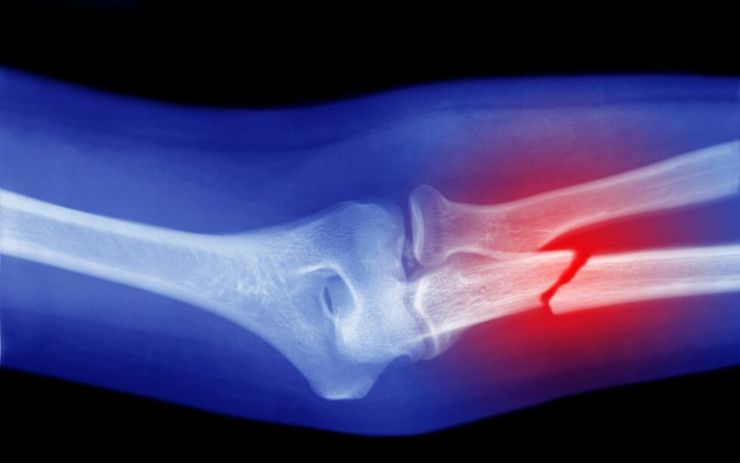Velocity Urgent Care is becoming Sentara Urgent Care
As part of the Sentara family of care, our name will be changing to Sentara Urgent Care on February 3, 2025.
Velocity Urgent Care is becoming Sentara Urgent Care
As part of the Sentara family of care, our name will be changing to Sentara Urgent Care on February 3, 2025.

A broken bone, or fracture, is something no one wants to experience. But unfortunately, fractures are a common injury for both children and adults. Each year, approximately 6.3 million broken bones occur in the U.S. alone and happen in nearly three out of every 100 people.So what should you do if you experience a broken bone? Many people rush to the emergency room. However, most minor fractures don’t need to be treated at the ER and you could leave with a hefty medical bill for services you don’t need.
Still, most fractures do need some care and should be examined by a medical professional. This makes urgent care an excellent choice for many broken bones and minor injuries. In this article, we’ll discuss different types of fractures, how to tell if you’ve broken a bone, and how to decide where to seek care for a broken bone.
Not all broken bones are alike. Although our bones are incredibly strong, they can break in many ways. This leads to different types of fractures—some of which require special care so they heal correctly.
When you break a bone, the first step is to determine if the fracture is open or closed. As the name suggests, an open fracture (or compound fracture) happens when the broken bone tears through the skin and is visible. Closed fractures (also called simple fractures) are much more common and happen when the bone is broken but the skin remains intact.
Doctors have unique names for the types of fractures based on how the bone breaks. You’ll need to have an x-ray to determine which type of fracture you have. Importantly, the way your bone is broken will determine what type of treatment you need and how long the recovery process will take.
A few of the most common types of fractures include:
Transverse fracture: The bone is broken in a straight line across.
Oblique fracture: The break occurs in a diagonal line across the bone.
Comminuted fracture: The bone breaks into three or more pieces with small fragments at the site.
Greenstick fracture: Common in children, the bone is broken but not all the way, causing the non-broken side to bend.
Spiral fracture: A break that twists around the bone that can occur with sports injuries and falls.
Fractures can occur with many types of injuries and accidents. A fall, car crash, or blow to the body can all lead to a broken bone. A fracture happens when more force is applied to your bone than it can withstand, causing it to break.
After a fracture, most people experience sudden pain in the injured area and may have difficulty moving the affected area or their nearby joints. Signs of a broken bone include:
Sudden, intense pain
Difficulty moving
Trouble putting weight on the affected area
Swelling
Deformity of the area
Warmth, bruising, and redness
If you think you have a broken bone, you should always seek medical care immediately. The right treatment helps ensure your bone heals correctly and prevents long-term complications like chronic pain and decreased mobility. Only a medical provider with an x-ray knows how to diagnose a fracture and properly “set” or realign the broken bone so it can heal.
For many broken bones, urgent care is an excellent choice. When you have a fracture that isn’t severe, urgent care can quickly diagnose and treat your injury. Most urgent care locations have an x-ray machine on-site. Plus, urgent care providers treat broken bones every day and are well-trained to handle common fractures.
Many people don’t know they can choose urgent care to treat a broken bone. But for minor fractures, urgent care is a quick, effective solution that can save you money on medical bills.
Although urgent care can handle most fractures, there are some cases where it’s better to choose the emergency room. Here, providers have the needed resources to handle complex fractures, including those that may need surgery to repair.
If you have a fracture with any of the following, head to the nearest emergency room or call 911 immediately:
Bone sticking through the skin or there is obvious deformity
Heavy bleeding
The injury is along the spine, head, or back
Numbness, tingling, or pale skin in the area
You are older than 65 or a child is less than 5 years old (due to increased risk of complications)
If you’ve suffered a minor fracture and need help, Velocity Urgent Care has your back. We treat broken bones every day and our providers are ready to help get you back on track.
We have an on-site x-ray machine at each of our convenient locations and can diagnose your fracture and provide the necessary treatment right away. If your fracture needs more complex care, we’ll provide a referral to the emergency room or an orthopedic specialist for a follow-up. We can also prescribe pain medication and alternative pain relief methods to help during your recovery.
Whenever you need immediate medical care for an accident, injury, or illness, we’re ready to help. Just walk in to any of our convenient locations or make an appointment with our online registration portal to skip the waiting room and arrive when it’s your turn to be seen. We even offer text message updates so you can wait in the car (if you prefer) until it’s time for your appointment.
Velocity Urgent Care is an in-network provider for most major insurance plans, meaning you can be seen for the cost of your co-pay and deductible.
All our locations also accept Medicare, Medicaid, and Tricare. Veterans Administration beneficiaries are also welcome.